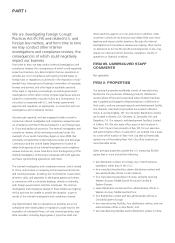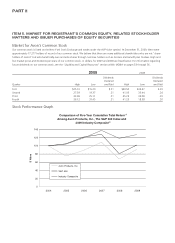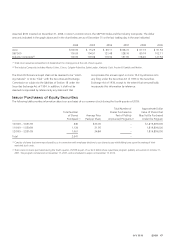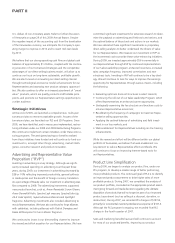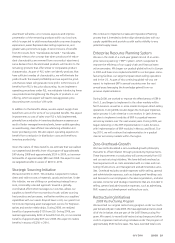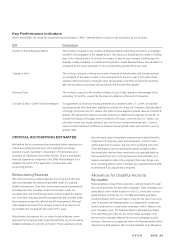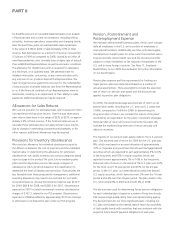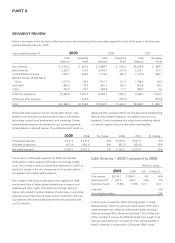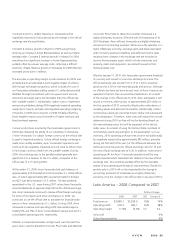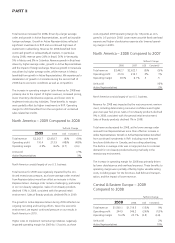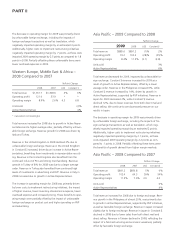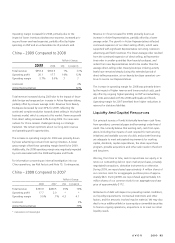Avon 2009 Annual Report Download - page 41
Download and view the complete annual report
Please find page 41 of the 2009 Avon annual report below. You can navigate through the pages in the report by either clicking on the pages listed below, or by using the keyword search tool below to find specific information within the annual report.
Key Performance Indicators
Within this MD&A, we utilize the key performance indicators (“KPIs”) defined below to assist in the evaluation of our business.
KPI Definition
Growth in Active Representatives This indicator is based on the number of Representatives submitting an order in acampaign,
totaled forall campaigns in the related period. This amount is divided by thenumber of billing
days in the related period, to exclude the impact of year-to-year changes in billing days (for
example, holiday schedules). To determine the growthinActive Representatives, this calculation is
compared to the same calculation in the corresponding period of the prior year.
Change in Units This indicator is based on the gross number of pieces of merchandise sold during aperiod,
as compared to the same number in the same period of the prior year. Units sold include
samples sold and product contingent upon the purchase of another product (for example,
gift with purchase or purchase with purchase), but exclude free samples.
Inventory Days This indicator is equal to the number of days of cost of sales, based on the average of the
preceding 12 months, covered by the inventory balance at the end of the period.
Constant $(Non- GAAP Financial Measure) To supplement our financial results presented in accordance with U.S. GAAP, we disclose
operating results that have been adjusted to exclude the impact of changes in the translation
of foreign currencies into U.S. dollars. We refer to these adjusted growth rates as Constant $
growth. We believe this measure provides investors an additional perspective on trends. To
exclude the impact of changes in the translation of foreign currencies into U.S. dollars, we
calculate current year results and prior year results at aconstant exchange rate. Currency
impact is determined as the difference between actual growth rates and constant currency
growth rates.
CRITICAL ACCOUNTING ESTIMATES
We believe the accounting policies described below represent our
critical accounting policies due to the estimation processes
involved in each. See Note 1, Description of the Business and
Summary of Significant Accounting Policies, of our consolidated
financial statements contained in this 2009 Annual Report for a
detailed discussion of the application of these and other
accounting policies.
Restructuring Reserves
We record severance-related expenses once they are both prob-
able and estimable for severance provided under an ongoing
benefit arrangement. One-time, involuntary benefit arrangements
and disposal costs, primarily contract termination costs, are
recorded when the benefits have been communicated to employ-
ees. One-time, voluntary benefit arrangements are recorded when
the employee accepts the offered benefit arrangement. We eval-
uate impairment issues if the carrying amount of an asset is not
recoverable and exceeds the fair value of the asset.
We estimate the expense for our restructuring initiatives, when
approved by the appropriate corporate authority, by accumulating
detailed estimates of costs for such plans. These expenses include
the estimated costs of employee severance and related benefits,
impairment of property, plant and equipment, contract termi-
nation payments for leases, and any other qualifying exit costs.
These estimated costs are grouped by specific projects within
the overall plan and are then monitored on aquarterly basis by
finance personnel. Such costs represent our best estimate, but
require assumptions about the programs that may change over
time, including attrition rates. Estimates are evaluated periodically
to determine if an adjustment is required.
Allowances for Doubtful Accounts
Receivable
Representatives contact their customers, selling primarily through
the use of brochures for each sales campaign. Sales campaigns are
generally for atwo-week duration in the U.S. and atwo- to four-
week duration outside the U.S. The Representative purchases
products directly from us and may or may not sell them to an end
user. In general, the Representative, an independent contractor,
remits apayment to us each sales campaign, which relates to the
prior campaign cycle. The Representative is generally precluded
from submitting an order for the current sales campaign until
the accounts receivable balance for the prior campaign is paid;
however, there are circumstances where the Representative fails to
make the required payment. We record an estimate of an allowance
AVON2009 23



